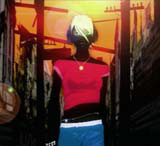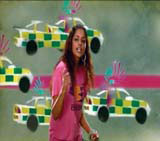Profile: Foreign Office

At Foreign Office, the contrasting skills, nationalities and creative approaches of the team make for an exciting and innovative mix. Yolanda Zappaterra meets the team who are pushing the boundaries of motion graphics.
The best design groups are usually driven by the creative energy, vision and drive of a single person. But, at motion graphics design group Foreign Office, three designers of different nationalities are bringing diverse skills together to achieve some extraordinary animation and – in the just-released Stephen Frears film ‘Mrs Henderson Presents’ – a film title sequence that is as lush and delightful as it is witty and intelligent.
Co-founder and Spaniard Sonia Ortiz Alcón is quick to admit that ‘three is a deadly combination. Getting consensus between three people is really, really hard.’ But she adds that the cultural knowledge and national temperaments of fellow co-founders Fredrik Nordbeck (Swedish), and Matteo Manzini (Italian) mean things are always interesting. It’s the trio’s widely varying skills and approaches to design that really make the mix work.
Ortiz Alcón, Nordbeck and Manzini met as graphic design students at Central St Martins College of Art and Design, where, having opted for the audio visual strand in their second year, they had to work as a small group and quickly realised they worked well together.
‘My interest lay in prioritising the message rather than the look. Sonia’s work was much looser, more arts-based, and Matteo’s passion was animation,’ recalls Nordbeck. One thing they do have in common is humour, and this is apparent in all of Foreign Office’s work, from a series of animated idents for MTV, based on the idea of a European Karma Sutra, to a series of shorts for an MTV/Motorola collaboration. It’s this, coupled with an understanding of the role of design in their work, that sets them apart from other motion graphics studios. ‘We’re not pure film-makers, or pure animators – there’s a very strong sense of design, which is slightly different to a linear film process,’ he says.

The way the trio work is also very collaborative. ‘We haven’t consciously adopted a system for the way we work,’ explains Ortiz Alcón. ‘We don’t work in sync, we don’t have set roles, and we don’t work as three independent designers. We sit down to brainstorm and develop ideas together,’ she says.
The resulting pieces are hard to describe, so varied and multi-textual is the work. There are affectionate, reverential nods back to things like Betty Boo, Felix the Cat, The Furry Freak Brothers and the work of Tex Avery, but there is no house style or overarching look to the work. ‘The only consistency is in the lack of consistency,’ says Ortiz Alcón.
While this is a natural outcome of the collaborative approach, it also reflects a determination to remain innovative and imaginative. Producing the right solution for the client, for Ortiz Alcón, means avoiding examination of the client’s tastes. ‘I don’t watch MTV because I don’t want to come up with MTV ideas, I want to come up with good Foreign Office ideas for MTV,’ she says. And it involves coming up with as many as 50 ideas at a brainstorm, which leads Nordbeck to occasionally worry about whether a simpler solution might better serve the client and end product.
Foreign Office recently made a move towards simplification, by deciding to focus almost exclusively on motion graphics, but there’s still a lot to be resolved. While their hearts are obviously attracted to the surreal, far out, crazy work, so beloved of MTV and Nickelodeon, the three are aware that other styles can not only inform their other work, but also offer opportunities for new directions, for example, a recent live action, big budget, very beautiful but very straight ad for Nokia – a collaboration with director Elliott. The lucrative ones can fund personal projects while helping the company to strengthen and grow.
‘As a small company, which is trying to mature and get out of the basement, Foreign Office wants to progress from a designer’s collective, where a lot of energy is spent on project management and production issues, into something that makes for a more enjoyable way of working. But, of course, there’s a fear that if you give up that process, then you might lose something. So it’s about trying to retain and distil the process, but make it more viable,’ says Nordbeck.
Things may be lost along the way – the creative space and time to produce the wonderfully idiosyncratic musings in the ‘playground’ space of the company’s website, for example – but Foreign Office is both pragmatic and upbeat about the future.
Pictured:
1 – Music promo designed by Foreign Office for Good Times by Ed Case featuring Skin
2 – Promo designed designed by Foreign Office for Galang by MIA
-
Post a comment



